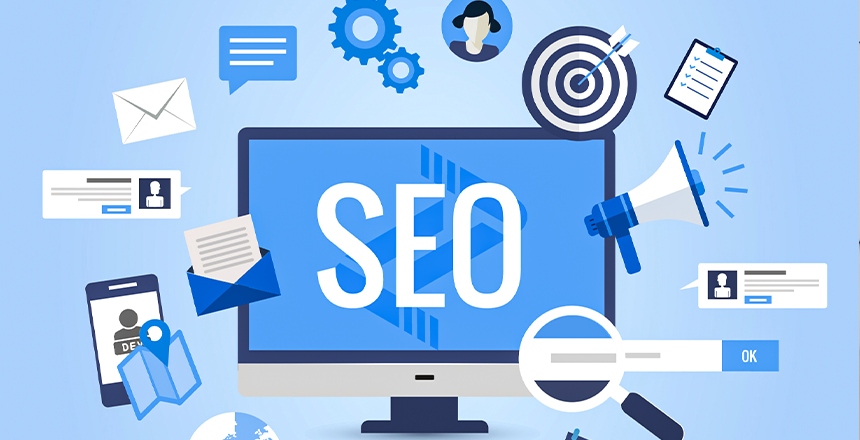In today's digital environment, online visibility is essential for businesses looking to stand out. With new content being published constantly, competition is intensifying every day. SEO (Search Engine Optimization) plays a central role in the quest for search engine ranking, making it an indispensable lever for any effective web development strategy.
1. The Current Digital Context
In the digital age, consumers have access to an almost unlimited amount of information at their fingertips. According to studies, over 90% of online experiences begin with a search engine. This means users type in keywords to find products, services, or specific information, and search results can make the difference between a click and being ignored. As a result, having a solid SEO strategy is not just optional but a strategic necessity for any business looking to increase its online presence.
2. What is SEO (Search Engine Optimization)?
SEO encompasses all the techniques and strategies aimed at improving a website’s ranking in search engine results such as Google, Bing, or Yahoo. It includes a variety of elements, from content and page structure optimization to backlink building and user experience enhancement. SEO is not a quick fix but rather a long-term investment that requires continuous monitoring and regular adjustments.
3. Why is SEO Crucial for Websites?
a. Visibility and Organic Traffic
One of SEO’s primary goals is to increase a website’s visibility on search engines. Most internet users never go past the first page of search results. In fact, about 75% of clicks go to the top three results. This means effective SEO optimization can greatly boost website visitors. Increased organic traffic is often linked to higher conversion rates, as visitors attracted by relevant results are more likely to make a purchase or engage with the brand.
b. Credibility and Trust
A site that ranks well in search results is generally seen as more credible and trustworthy by users. Consumers tend to trust brands that appear at the top of search results, as they are often seen as industry leaders. Therefore, investing in SEO not only improves visibility but also helps build trust with potential customers.
c. Enhanced User Experience
SEO isn’t just about keyword optimization; it also involves improving the user experience on the site. Search engines—especially Google—favor websites that provide a positive user experience, which includes fast load times, intuitive navigation, and relevant content. Focusing on user experience reduces bounce rates, keeping visitors on the site longer and increasing the chances of conversion.
d. Long-Term Cost-Effectiveness
Unlike paid ads, where each click has a cost, SEO-generated traffic is sustainable. Once a website reaches a high position in search results, it can continue receiving a steady flow of visitors without additional costs. This makes SEO a very cost-effective strategy in the long term, especially for small and medium-sized businesses looking to maximize their ROI.
4. Key Components of SEO
To optimize a site effectively, it’s essential to understand the different SEO components:
a. On-Page SEO
On-page SEO refers to the elements you can directly control on your website, such as:
Keyword Optimization: Identify relevant keywords and integrate them into content, title tags, meta descriptions, and URLs. Using long-tail keywords can also help attract a more targeted audience.
Quality Content: Creating original and informative content that addresses user questions and needs is crucial. Search engines favor content that provides value to users, such as blog articles, how-to guides, and case studies.
HTML Tags and Structure: Proper use of HTML tags helps structure content and improve readability. A well-structured site also makes navigation easier for both users and search engines.
b. Off-Page SEO
Off-page SEO refers to actions taken outside your website to improve its ranking. Strategies include:
Backlinks: Acquiring high-quality inbound links from other websites is essential for increasing your site’s authority. Backlinks are a key ranking factor, as they indicate that others consider your content valuable.
Social Media Marketing: Promoting your content on social media can generate additional traffic to your site. Active engagement on these platforms also helps build a community around your brand.
c. Technical SEO
Technical SEO covers the backend aspects of your website that impact how search engines index it. Key elements include:
Loading Speed: Slow-loading websites can frustrate users and harm rankings. Optimizing site speed is critical to improving user experience.
Mobile-Friendliness: With the rise of mobile device usage, it’s crucial for your site to be responsive and optimized for smartphones and tablets. Google prioritizes mobile-friendly websites in its rankings.
Security: A secure website (HTTPS) is vital not only for protecting user data but also for building trust and improving rankings.
5. Steps to Implement an Effective SEO Strategy
To maximize your SEO impact, follow a structured process:
a. SEO Audit
Start with a comprehensive SEO audit of your site. Evaluate keywords, structure, content quality, and technical performance. An audit helps identify weak spots and areas for improvement.
b. Keyword Research
Find relevant keywords for your industry and target audience. Use tools like Google Keyword Planner or SEMrush to discover keywords with good search volume and reasonable competition. This will help guide your content strategy.
c. Content Creation
Consistently produce quality content, such as blog posts, videos, infographics, and more. Use an editorial calendar to ensure your content stays fresh and relevant.
d. Technical Optimization
Ensure your site is technically optimized, especially in terms of loading speed, mobile responsiveness, and security. You may need to work with web developers to cover all technical aspects.
e. Monitoring and Analytics
Use tools like Google Analytics to track your site’s performance. This allows you to measure your strategy’s effectiveness and make necessary adjustments. Data analysis is key to understanding what works and what needs improvement.


SEO is an essential pillar for improving online visibility, credibility, and conversions. Although it requires constant adaptation to algorithms, it delivers lasting results, making it a key investment to achieve your business goals.





